 Habibi, by Craig Thompson. I'm glad I read the book before I read Nadim Damluji's nicely considered review The Spectre of Orientalism in Craig Thompson’s Habibi at the Hooded Utilitarian. Otherwise I wouldn't be able to look at the expanse of desert on the rear endpapers without seeing it as an editorial cartoon minefield, with submerged bombs labelled 'orientalism,' 'ethnocentrism,' 'primitivism,' 'exoticism' etc., or be able read the book without being in a tense state of 'how's he going to get all these worms back in the can?'
Habibi, by Craig Thompson. I'm glad I read the book before I read Nadim Damluji's nicely considered review The Spectre of Orientalism in Craig Thompson’s Habibi at the Hooded Utilitarian. Otherwise I wouldn't be able to look at the expanse of desert on the rear endpapers without seeing it as an editorial cartoon minefield, with submerged bombs labelled 'orientalism,' 'ethnocentrism,' 'primitivism,' 'exoticism' etc., or be able read the book without being in a tense state of 'how's he going to get all these worms back in the can?'Thompson's own remark in a recent interview creates more problems than it solves: "But I was also having fun thinking of Orientalism as a genre like Cowboys and Indians is a genre – they’re not an accurate representation of the American west, they’re like a fairy tale genre.” As a cowboy, I myself shot a dozen indians in the infamous incident at Glasgow Gulch, and to this day, fifty years later, when I see casual slaughter in the movies, and in kids' video games, I feel nauseated.
The thing about Craig Thompson is that he kind of exists in a state of blessed innocence. I can think of no other artist who could draw so many pages of nakidity and you come away thinking 'aw, he's such a sweetheart.' I even find myself wanting to protect him from all those jackals at the Hooded Utilitarian.
But let's not do that. I shall take a different tack altogether.
Thompson's need was not to tell us all about the geographical or political Middle East, either of today or yesteryear, but to find a narrative body that would carry him through the next stage of his development as an artist. For me, many years ago, Greek mythology served a similar purpose; I had no special interest in the subject prior to that. I just needed an engine that came ready built with all its interconnecting parts in place, that enabled me to encase stories within other stories right from the kick-off. The theme that commands Thompson in this early phase of his oeuvre is LOVE. He has taken it from the childlike cute of Goodbye Chunky Rice through the 'first love' of Blankets. And now a big subject was required, something with epic potential, a grand romance, something bigger than the familiar and the everyday. He sought and found it in the idiom of the Arabian Nights, with its sultans and harems and slaves and eunuchs. But more than a single linear story, Thompson wanted to erect a colossal structure with a baroque encrustation of teeming narratives. To this end he uses the literature of the Middle East, in both subject, using the Qur'an the bible and Arabic poetry, and in form, through the rich calligraphic tradition of the literature. At this point you would have to ask: is this guy nuts? Where did he get the courage to take on all of that?
The funny part is that I always mentally filed Thompson with a newer wave of artists, like Kochalka, who rejected the byzantine complexities of Alan Moore's Watchmen and From Hell and plunked for a straightforward heart-on-sleeve, decompressed, uncomplicated brand of storytelling. Habibi is continually backtracking and jumping forward and freezing for analogical insertions and philosophical digressions. A calendar of pregnancy, an explanation of ancient chemistry, numerology, a cut away diagram of a ship, pictorial nods to 19th century painters such as Rossetti, Ingres. And that's just off the top of my head
One of Damluji's criticisms:
Wanatolia represents the heart of Habibi’s most problematic elements. In the sense that Habibi is a fairy tale (which Thompson has stated he was intending to create) it is understandable that the city is constructed as “timeless.” In other words, the majority of Dodola and Zam’s story isn’t tied to an analogous timeline. The problem arises when in the latter chapters of the book Thompson reveals that the same backward setting of Wanatolia (which houses the harem filled palace of the Sultan) dually houses a modern urban city. When Dodola and Zam return to Wanatolia after escaping the palace and recouping with a fisherman, we see the city in a completely new light: it is now a vibrant bustling city with billboards for Coca-Cola and Pepsi, SUVs, and free women pushing strollers...This strikes me as an overly linear reading of the work. By the time you get to that part of the book, with all its parables and tangents, It's difficult to think of the action as taking place in a city or a time in any real sense. Will any reader think that the sea of junk, for instance, is supposed to be literal? It's all in ideaspace, to refer to Alan Moore's concept, where one thing and its opposite tend to exist in immediate juxtaposition. And it fits perfectly with the tradition of the Nights (without getting into the complications of how they got the way they are):
...The entire events of the book are retroactively a modern reality in the wake of an urban Wanatolia.
The tales vary widely: they include historical tales, love stories, tragedies, comedies, poems, burlesques and various forms of erotica. Numerous stories depict Jinns, Ghouls, Apes, sorcerers, magicians, and legendary places, which are often intermingled with real individuals and geography, not always rationally...Next time, some thoughts about the art in Habibi.
Labels: Craig Thompson, new books (3)
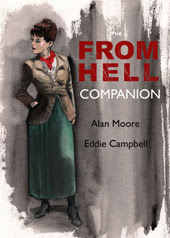


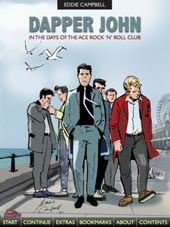
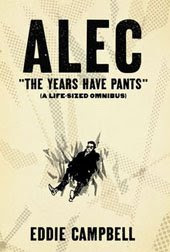
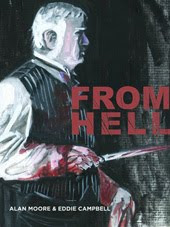
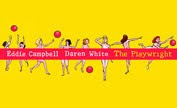
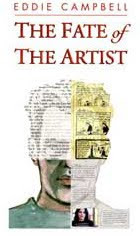
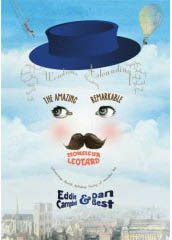





12 Comments:
Hi Eddie-
I would be interested to hear your take on the ethical choices involved as an artist with this kind of representation. Surely the artist has the right to engage in whatever material s/he wishes, but the artist is also a human being and as a human should also be considering the legacy of racism and colonialism that continue to give weight and substance to the Orientalist fantasy in the form of justification for real and terrible oppression. Another word for Thompson's innocence might be white privilege. He thinks he can divorce his art from its context because he has good intentions, but he also is not the one who has to put up with the continued racist bullshit of being, just for example, an Arab living in the United States these days. Racist bullshit that frankly it sounds like this book perpetuates.
I am not reading this before reading the thing first and see what it has to say (or show) for itself.
Cant someone just create a story, no matter where or when it is set, to entertain people without someone carrying on like a frog in a sock. I think some people will bend over backwards to find a negative slant in anything so they can come off like some self rightous git and point fingers. What I have read of Habibi Ifound interesting and enjoyed the art.
Mortal Ken
Ethan,
"sounds like this book perpetuates."
sounds like someone spouting forth about something he hasn't read.
but, anyway, It took me several days to get all my words airtight, so I'm not going to ruin it by blathering half-assedly down here in the comments.
I like your 'Ethan Comics'
Best to you,
Eddie
Hi Eddie-
Thanks! Very much appreciate the kind words. Anyways, not trying to be an angry ranter. I am genuinely interested in your opinion on the questions of ethical representation and art at a more broad level outside the specifics of Thompson's work. I absolutely want to be forthright in stating (and I should have in my comment above) that I have not read Habibi yet, and I do plan to as soon as I can get a copy from the library. My opinion is entirely based on the reviews and the interviews with Thompson I have read, and should not be taken as a review of or opinion about Habibi as a book, but rather an opinion about the questions that Thompson seems to be raising, and the fact that he seems to be forgetting or ignorant of or deliberately ignoring a major point of Said's critique (which I have read). Cheers,
Ethan,
I spent two or three days chasing down the relevant ideas that are involved here (if you backtrack a few days in my blog you'll see that I delayed posting on the subject of Habibi). The problem is that a proper study of the matter will take weeks, if not forever, viz:
"Lewis answered with several essays in response, and was joined by other scholars, such as Maxime Rodinson, Jacques Berque, Malcolm Kerr, Aijaz Ahmad, and William Montgomery Watt, who also regarded (Said's book) Orientalism as a deeply flawed account of Western scholarship."
I doubt very much that Thompson chased down all the arguments. He's an artist, not a thinker. And as an artist I am very fond of his work, including Habibi.
I'd like to address some of the accusations of Orientalism in this book. I'm not going to take on the largest arguments about it (I'll leave that for readers of Said), but I will say this: Thompson did his research. I'm thinking specifically of the harem setting, which is pretty much the quickest way to get the finger of Orientalism pointed and wagging at you. His portrayal is a very well-researched depiction of the Ottoman harem, specifically, down to the Mimar Sinan architecture and the fact that "harem" really only means "women's quarters". Some of the girls were there as concubines, but many were there in palace service, or had been born there. And, yes, there were abducted or sold girls from all over the Empire there. And African female servants. And African eunuchs. These are historical facts. So you can get pissed off when someone mentions them, or you can simply understand them in their context. He even got the style of head covering right when the girls go out into the garden. I appreciated his level of research in this area, and elsewhere, because I'm a student of that time and place, myself.
Now, does a creator get tarred with the Orientalism brush if he or she is from that region? Did anyone call Rabih Alameddine's "The Hakawati" Orientalist, or does he get a pass because he's Lebanese? How about the awesome and ridiculous Turkish soap opera, "Maginficent Century", set in the Topkapi Palace, about the great love affair of Suleiman and Roxelana? Actually, that one angered my Turkish friend a lot, but for different reasons.
It's hard to represent another culture, but it's very important to try. I can tell you from personal experience as an Arabic folkloric dancer that there is no way of working in that dance form without encountering Orientalism from all sides, and believe me, it is deployed in the Middle East to sell tourists stuff all the time. But there's also no "-Ism" attached to genuine love of architecture, music, graphic patterns, storytelling, and language of a culture not your own. The message underlying so much of the queasiness around it is, "Stick to your own kind". If Craig did that, all you'd get year after year would be comics about contemporary Wisconsin and Portland. That sounds pretty deadly to me.
ps - I meant to add, my comments were intended to be general. I really appreciate what you wrote, Eddie, and I wasn't criticizing it!
thanks for your comments, Leela.
Thank you, Eddie and Leela, for putting your fingers on what's been bothering me about the whole "it's exoticism"-angle on Western/white creators depicting a non-Western/non-white mileu or culture. It's a creative person's role in life to put themselves in other people's shoes and imagine other places, and their example then allows the rest of us to do it too. That is an amazing thing, and I think that the artists' audience are discerning and sensitive enough to not have to be "protected" by any Moral Majority, whether they come from the Left or the Right.
(I should say I'm a black leftie from Sweden, just so no one can try to paint me as something I'm not.)
Hi Eddie,
I really appreciate the link and the response to my review. It is extraordinarily flattering to see an artist I admire respond so thoughtfully to something I wrote.
I mainly want to chime this late in the game to say that I was spurred to write the review because I hadn't yet seen an analysis of Orientalism in the text, or when I had it was brushed off in the same sentence it was brought up. I didn't have an agenda going in to the book about how I wanted to read it, but I thought it was worthwhile writing up my honest reaction to it afterwards.
I also feel the need to reiterate that my concern is why he chose the vessel he did in Habibi. I understand and respect the impulse by Thompson (or any artist) to pluck from cultures and times to explore whatever themes they want, but I just want to call to question the power dynamics embedded in those choices. So my critique isn't "stick to your own kind" as Leela suggests, but more "try to use nuance when claiming to represent other peoples lived experiences." On that, I think all the research he did is commendable (hence me commending him) but again it is all muddled when he crosses those lines between fantasy and modern reality so that you no longer have a sense of that history being in the past.
I respect that you disagree with this assesment by pointing at ideaspace, but that is why I am so interested in intent vs. outcome. My reading might be overly linear, but that is a reading I think is fare considering that Thompson's first draft was a much more straightforward narrative.
Anyhow, I wanted to insert the idea of Orientalism into discussion of Habibi and for my part I am happy that that is happening here and elsewhere.
Thanks, Nadim
Your comment went into my spam folder for some reason, and I missed it for an hour or two (I deleted your re-send). (and I've finally got the spam problem under control here at campbell.blogspot, many will be glad to hear). I enjoyed your essay. I thought it was well considered. I was a bit alarmed however when you thanked Suat for his support. There lies chaos. :)
I see Sean Collins is now playing at "let's you and him fight".
Eddie
Post a Comment
Subscribe to Post Comments [Atom]
<< Home